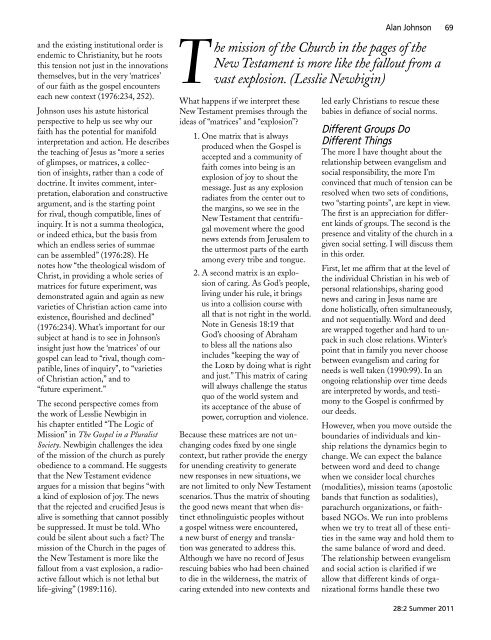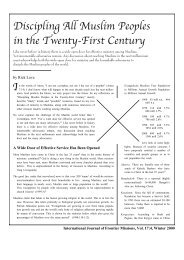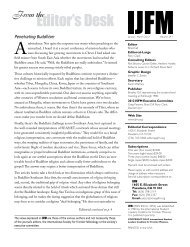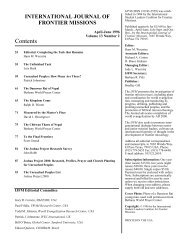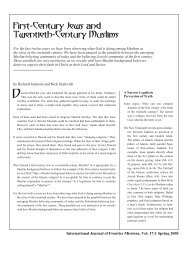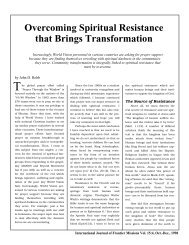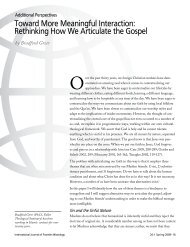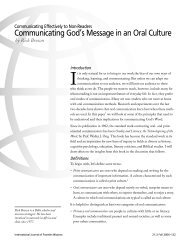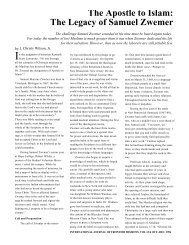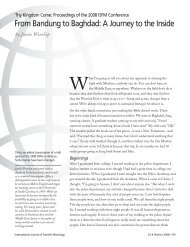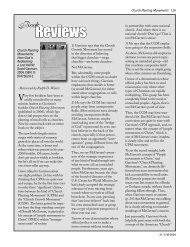Mission as Word and Deed: Transcending the Language of Priority
Mission as Word and Deed: Transcending the Language of Priority
Mission as Word and Deed: Transcending the Language of Priority
You also want an ePaper? Increase the reach of your titles
YUMPU automatically turns print PDFs into web optimized ePapers that Google loves.
<strong>and</strong> <strong>the</strong> existing institutional order is<br />
endemic to Christianity, but he roots<br />
this tension not just in <strong>the</strong> innovations<br />
<strong>the</strong>mselves, but in <strong>the</strong> very ‘matrices’<br />
<strong>of</strong> our faith <strong>as</strong> <strong>the</strong> gospel encounters<br />
each new context (1976:234, 252).<br />
Johnson uses his <strong>as</strong>tute historical<br />
perspective to help us see why our<br />
faith h<strong>as</strong> <strong>the</strong> potential for manifold<br />
interpretation <strong>and</strong> action. He describes<br />
<strong>the</strong> teaching <strong>of</strong> Jesus <strong>as</strong> “more a series<br />
<strong>of</strong> glimpses, or matrices, a collection<br />
<strong>of</strong> insights, ra<strong>the</strong>r than a code <strong>of</strong><br />
doctrine. It invites comment, interpretation,<br />
elaboration <strong>and</strong> constructive<br />
argument, <strong>and</strong> is <strong>the</strong> starting point<br />
for rival, though compatible, lines <strong>of</strong><br />
inquiry. It is not a summa <strong>the</strong>ologica,<br />
or indeed ethica, but <strong>the</strong> b<strong>as</strong>is from<br />
which an endless series <strong>of</strong> summae<br />
can be <strong>as</strong>sembled” (1976:28). He<br />
notes how “<strong>the</strong> <strong>the</strong>ological wisdom <strong>of</strong><br />
Christ, in providing a whole series <strong>of</strong><br />
matrices for future experiment, w<strong>as</strong><br />
demonstrated again <strong>and</strong> again <strong>as</strong> new<br />
varieties <strong>of</strong> Christian action came into<br />
existence, flourished <strong>and</strong> declined”<br />
(1976:234). What’s important for our<br />
subject at h<strong>and</strong> is to see in Johnson’s<br />
insight just how <strong>the</strong> ‘matrices’ <strong>of</strong> our<br />
gospel can lead to “rival, though compatible,<br />
lines <strong>of</strong> inquiry”, to “varieties<br />
<strong>of</strong> Christian action,” <strong>and</strong> to<br />
“future experiment.”<br />
The second perspective comes from<br />
<strong>the</strong> work <strong>of</strong> Lesslie Newbigin in<br />
his chapter entitled “The Logic <strong>of</strong><br />
<strong>Mission</strong>” in The Gospel in a Pluralist<br />
Society. Newbigin challenges <strong>the</strong> idea<br />
<strong>of</strong> <strong>the</strong> mission <strong>of</strong> <strong>the</strong> church <strong>as</strong> purely<br />
obedience to a comm<strong>and</strong>. He suggests<br />
that <strong>the</strong> New Testament evidence<br />
argues for a mission that begins “with<br />
a kind <strong>of</strong> explosion <strong>of</strong> joy. The news<br />
that <strong>the</strong> rejected <strong>and</strong> crucified Jesus is<br />
alive is something that cannot possibly<br />
be suppressed. It must be told. Who<br />
could be silent about such a fact The<br />
mission <strong>of</strong> <strong>the</strong> Church in <strong>the</strong> pages <strong>of</strong><br />
<strong>the</strong> New Testament is more like <strong>the</strong><br />
fallout from a v<strong>as</strong>t explosion, a radioactive<br />
fallout which is not lethal but<br />
life-giving” (1989:116).<br />
What happens if we interpret <strong>the</strong>se<br />
New Testament premises through <strong>the</strong><br />
ide<strong>as</strong> <strong>of</strong> “matrices” <strong>and</strong> “explosion”<br />
1. One matrix that is always<br />
produced when <strong>the</strong> Gospel is<br />
accepted <strong>and</strong> a community <strong>of</strong><br />
faith comes into being is an<br />
explosion <strong>of</strong> joy to shout <strong>the</strong><br />
message. Just <strong>as</strong> any explosion<br />
radiates from <strong>the</strong> center out to<br />
<strong>the</strong> margins, so we see in <strong>the</strong><br />
New Testament that centrifugal<br />
movement where <strong>the</strong> good<br />
news extends from Jerusalem to<br />
<strong>the</strong> uttermost parts <strong>of</strong> <strong>the</strong> earth<br />
among every tribe <strong>and</strong> tongue.<br />
2. A second matrix is an explosion<br />
<strong>of</strong> caring. As God’s people,<br />
living under his rule, it brings<br />
us into a collision course with<br />
all that is not right in <strong>the</strong> world.<br />
Note in Genesis 18:19 that<br />
God’s choosing <strong>of</strong> Abraham<br />
to bless all <strong>the</strong> nations also<br />
includes “keeping <strong>the</strong> way <strong>of</strong><br />
<strong>the</strong> Lord by doing what is right<br />
<strong>and</strong> just.” This matrix <strong>of</strong> caring<br />
will always challenge <strong>the</strong> status<br />
quo <strong>of</strong> <strong>the</strong> world system <strong>and</strong><br />
its acceptance <strong>of</strong> <strong>the</strong> abuse <strong>of</strong><br />
power, corruption <strong>and</strong> violence.<br />
Alan Johnson 69<br />
The mission <strong>of</strong> <strong>the</strong> Church in <strong>the</strong> pages <strong>of</strong> <strong>the</strong><br />
New Testament is more like <strong>the</strong> fallout from a<br />
v<strong>as</strong>t explosion. (Lesslie Newbigin)<br />
Because <strong>the</strong>se matrices are not unchanging<br />
codes fixed by one single<br />
context, but ra<strong>the</strong>r provide <strong>the</strong> energy<br />
for unending creativity to generate<br />
new responses in new situations, we<br />
are not limited to only New Testament<br />
scenarios. Thus <strong>the</strong> matrix <strong>of</strong> shouting<br />
<strong>the</strong> good news meant that when distinct<br />
ethnolinguistic peoples without<br />
a gospel witness were encountered,<br />
a new burst <strong>of</strong> energy <strong>and</strong> translation<br />
w<strong>as</strong> generated to address this.<br />
Although we have no record <strong>of</strong> Jesus<br />
rescuing babies who had been chained<br />
to die in <strong>the</strong> wilderness, <strong>the</strong> matrix <strong>of</strong><br />
caring extended into new contexts <strong>and</strong><br />
led early Christians to rescue <strong>the</strong>se<br />
babies in defiance <strong>of</strong> social norms.<br />
Different Groups Do<br />
Different Things<br />
The more I have thought about <strong>the</strong><br />
relationship between evangelism <strong>and</strong><br />
social responsibility, <strong>the</strong> more I’m<br />
convinced that much <strong>of</strong> tension can be<br />
resolved when two sets <strong>of</strong> conditions,<br />
two “starting points”, are kept in view.<br />
The first is an appreciation for different<br />
kinds <strong>of</strong> groups. The second is <strong>the</strong><br />
presence <strong>and</strong> vitality <strong>of</strong> <strong>the</strong> church in a<br />
given social setting. I will discuss <strong>the</strong>m<br />
in this order.<br />
First, let me affirm that at <strong>the</strong> level <strong>of</strong><br />
<strong>the</strong> individual Christian in his web <strong>of</strong><br />
personal relationships, sharing good<br />
news <strong>and</strong> caring in Jesus name are<br />
done holistically, <strong>of</strong>ten simultaneously,<br />
<strong>and</strong> not sequentially. <strong>Word</strong> <strong>and</strong> deed<br />
are wrapped toge<strong>the</strong>r <strong>and</strong> hard to unpack<br />
in such close relations. Winter’s<br />
point that in family you never choose<br />
between evangelism <strong>and</strong> caring for<br />
needs is well taken (1990:99). In an<br />
ongoing relationship over time deeds<br />
are interpreted by words, <strong>and</strong> testimony<br />
to <strong>the</strong> Gospel is confirmed by<br />
our deeds.<br />
However, when you move outside <strong>the</strong><br />
boundaries <strong>of</strong> individuals <strong>and</strong> kinship<br />
relations <strong>the</strong> dynamics begin to<br />
change. We can expect <strong>the</strong> balance<br />
between word <strong>and</strong> deed to change<br />
when we consider local churches<br />
(modalities), mission teams (apostolic<br />
b<strong>and</strong>s that function <strong>as</strong> sodalities),<br />
parachurch organizations, or faithb<strong>as</strong>ed<br />
NGOs. We run into problems<br />
when we try to treat all <strong>of</strong> <strong>the</strong>se entities<br />
in <strong>the</strong> same way <strong>and</strong> hold <strong>the</strong>m to<br />
<strong>the</strong> same balance <strong>of</strong> word <strong>and</strong> deed.<br />
The relationship between evangelism<br />
<strong>and</strong> social action is clarified if we<br />
allow that different kinds <strong>of</strong> organizational<br />
forms h<strong>and</strong>le <strong>the</strong>se two<br />
28:2 Summer 2011


